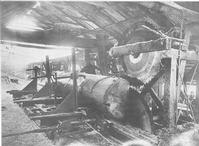


Chapter 4
I Management Of Native Forests
II Plantations-high Productivity Resources
III Protecting The Resource
IV Harvesting The Resource
V Solid Wood And Its Processing
i Sawmilling
ii Drying
iii Preservation
iv Quality and standards
VI Minor Forest Products
VII Reconstituted Wood Products
VIII Pulp And Paper
IX Export Woodchips
X Future Directions
XI Acknowledgements
References
Index
Search
Help
Contact us

Sawmilling
Compared with the overseas woods for which the early sawmilling technology was developed the most widely used Australian woods -the eucalypts -were denser and harder to saw, often of larger diameter and with a relatively high defect content -a hollow core, heart rot, brittle heart, gum veins arising from fire, insect attack or mechanical damage, or various types of fibre separation (checks, splits and shakes) arising from stresses to the growing tree or occurring during felling or log storage.The early mills were often built on sites with a slight gradient to facilitate movement of the heavy wood. Because of the large diameter of many of the logs the 'breaking down' operation was generally done using a 'twin rig' -one saw mounted above the other and cutting in the same plane. This could handle logs up to about 1.5 metres in diameter and any above this size would be cut on a slow speed frame saw or split. The twin rig method was introduced from Canada and its adaptation to the dense and abrasive eucalypts required considerable skill, particularly in optimizing saw design. The simple log carriages used, however, did not allow positioning the log so that accurately sized flitches could be obtained.
The breaking-down operation was followed by up to three 'breast benches', table top circular saw benches of simple design on which the flitches were transported to the saw on powered, reversible rollers or by chains. The sawing operations were completed on these versatile units which were ideal for defective wood removal, but rather labour-intensive. They appear to have been an Australian innovation and later spread to New Zealand, South Africa, the Pacific Islands and parts of South America.
The technological development of the industry was slow over a long period. Among the improvements introduced, however, were log carriages on which the logs could be more accurately positioned with hand-operated 'knees' or 'dogs' and the replacement of steam power by diesel or electricity and gravity by mechanical transfers. About 1920 bandsawing, a more costly method to instal than circular sawing but one that gave advantages in output and reduced waste, was introduced in some larger ash sawmills in Tasmania following its development in the West Coast mills of North America. It later spread to some Victorian ash mills and in the 1960s to a large karri mill in Western Australia.

Because of rising costs and the declining availability of large, high quality hardwood logs in the mid-1950s the industry began to undergo rationalization and to introduce increased mechanization and improved technology generally. Further advances in log carriage design enabled faster and more accurate positioning of the log, which in turn allowed more size reduction and defect removal to be carried out by the breaking-down saws, thereby increasing overall productivity. As the supply of large logs continued to decrease the industry began to use the smaller logs available from the eucalypt regrowth forests, which were starting to be seen as the main hardwood resource of the future. Major problems, however, began to be experienced in their conversion, arising from their high levels of growth stress.
 |
Australian Academy of Technological Sciences and Engineering |  |
© 1988 Print Edition page 216, Online Edition 2000
Published by Australian Science and Technology Heritage Centre, using the Web Academic Resource Publisher
http://www.austehc.unimelb.edu.au/tia/226.html